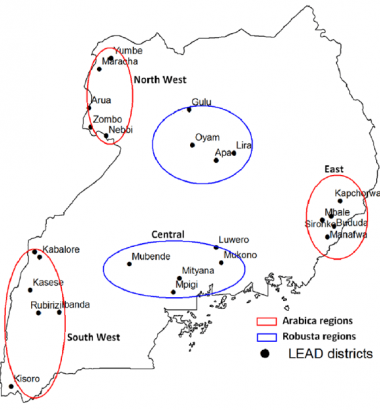Coffee Farming Facts in Uganda
HOW COFFEE FARMING WORKS IN UGANDA
East Africa is home to some of the world’s finest coffees, renowned for their rich flavors and unique profiles. Much of this excellence is attributed to the region’s cooperative farming systems, often organized around washing stations and well-known wet mills. This region is, in fact, the birthplace of coffee.
In Uganda, coffee has long stood as the most important cash crop, holding its place as the country’s top export earner since the 1980s. Uganda specializes in two main types of coffee: Arabica, grown at high altitudes ranging from 1,300 to 2,300 meters above sea level, and Robusta, cultivated at lower altitudes between 900 and 1,500 meters. The combination of altitude, fertile soils, and traditional farming systems gives Ugandan coffee its distinctive and exceptional quality—characteristics rarely found elsewhere in the world. Arabica coffee is primarily cultivated in the high-altitude regions of southeastern and southwestern Uganda.
Coffee is grown across five major regions: Central, Western, Southwestern, Northern, and Eastern Uganda. The Eastern region includes the Busoga sub-region (known for Robusta) and the Mount Elgon area (known for Arabica). The Northern region includes both the Mid-North (Robusta) and Northwestern areas, where both Arabica and Robusta are grown. Western and Southwestern regions also produce both varieties.
Uganda cultivates two main varieties of Robusta—Nganda and Erecta—while Clonal Robusta, a high-yielding variety that produces nearly four times more than traditional trees, is increasingly being planted to replace aging or diseased plants. As for Arabica, the varieties include SL28 (high altitude), SL14 (medium altitude), KP423 (medium altitude), and the traditional Nyasaland, found in Mount Elgon, the Rwenzori region, and the Zeu Mountains of Zombo District.
Coffee production in Uganda involves an estimated 1.7 million smallholder farmers across 108 districts. Robusta grows at altitudes of 800 to 1,400 meters above sea level, while Arabica thrives from 1,300 up to 2,300 meters. The high elevation contributes to the distinctive quality of Ugandan Robusta, which is known for its unique flavor attributes and superior cup profile.
Today, Rubzy is proud to be part of this rich coffee heritage. We support and promote sustainable and specialty coffee farming, connecting Uganda’s finest beans with niche markets that value premium quality and ethical sourcing.
In 2020, Uganda surpassed Ethiopia to become Africa’s largest coffee exporter, marking a significant milestone in the country’s coffee journey.
Robusta Coffee Production
Rubzy takes pride in sourcing and working with Uganda’s finest Robusta coffee, derived from the Coffea canephora plant. Robusta predominantly grows in the Lake Victoria Basin and is recognized for its low acidity, high bitterness, and strong, full-bodied flavor—traits that set it apart from Coffea arabica. Arabica typically thrives at higher altitudes (1,300–2,300 meters above sea level), while Robusta is cultivated between 900 and 1,500 meters. Though often considered less refined in taste, Robusta has several advantages that make it a valuable crop.
Robusta coffee is more robust and resilient—yielding higher outputs per hectare and requiring lower harvesting costs compared to Arabica. It is naturally more resistant to wilts and diseases, making it a reliable crop for farmers. Despite its stronger bitterness making it less popular on global specialty markets compared to Arabica, Robusta’s practical benefits and adaptability ensure it remains a key part of Uganda’s coffee economy.
Importantly, Robusta is native to Uganda, where it has grown wild in rainforests for centuries—one of the rare places in the world where coffee occurs naturally. While Arabica was introduced in the early 1900s, Robusta has been deeply rooted in Ugandan agricultural and cultural history. Wild Robusta still thrives in Uganda’s forests, representing a unique and invaluable genetic resource.
Historically, most Robusta has been sun-dried, but in recent years, efforts have been made to reintroduce wet-processing techniques. These initiatives, supported by the Uganda Coffee Development Authority (UCDA), aim to improve quality and tap into specialty markets. Back in the early 1960s, Uganda produced up to 25,000 tons of high-quality pulped and washed Robusta, but this segment declined during the monopoly years, alongside the collapse of the plantation sector. Today, over 500,000 smallholder farmers across the country grow Robusta, contributing significantly to Uganda’s coffee production.
Uganda’s native Robusta includes two traditional types: Nganda and Erecta. Through an extensive clonal replanting program, high-yielding clones of both types are being propagated. These clones are vegetatively reproduced and self-sterile, meaning their offspring remain true to type. They retain the parental traits of high yield, early maturity, larger bean size, and improved cup quality, while also demonstrating resistance to Coffee Leaf Rust.
Robusta grown in Uganda benefits from relatively high altitudes, sometimes reaching up to 1,500 meters above sea level. This contributes to a superior flavor profile, making Uganda’s Robusta increasingly attractive to the espresso market, where body and crema are essential. While much of the Robusta is still used in instant coffee and as a cost-effective blend component, there is growing potential for premium applications.
With Rubzy’s commitment to quality, sustainability, and innovation, Uganda’s Robusta is poised for a revival—delivering exceptional coffees to global markets while empowering the farmers who grow them.
Arabica Coffee Production
At Rubzy, we understand that Arabica coffee is a delicate crop that thrives under very specific conditions. Unlike Robusta, the Arabica coffee plant does not tolerate harsh climates, extreme temperatures, or frost. It prefers moderate humidity and flourishes in shaded environments, ideally at temperatures between 15°C and 24°C (59°F to 75°F).
Arabica is primarily grown at elevations of 600 meters (1,900 feet) or higher above sea level. It favors hillside terrain, where the cooler temperatures and well-drained soils contribute to the development of its complex flavor profile. The plant reaches full maturity around seven years of age.
In the wild, the Arabica tree can grow as tall as 9 to 12 meters, but for commercial cultivation, it is typically maintained at around 2 meters to facilitate easier harvesting—although it can grow up to 5 meters under managed conditions.
The coffee beans we know and love are actually seeds found inside the berries of the shrub-like Arabica plant. These berries resemble small cherries and are usually harvested when they reach a deep red or dark purple color, indicating ripeness. Each berry typically contains two coffee beans.
Similar to blueberries, Arabica berries do not ripen uniformly, which is why hand-picking is often the preferred harvesting method. Selecting only the ripe berries ensures higher quality coffee, as under-ripe beans can result in a bitter or flat cup.
Once the beans are extracted from the berries, they are still covered by two protective layers: the parchment coat and the silver skin, both of which must be carefully removed during processing to ensure a clean and flavorful bean.
At Rubzy, we prioritize quality from farm to cup, and our understanding of the Arabica plant’s growing needs allows us to support farmers in cultivating beans of exceptional character and taste.

What’s So Special About Ugandan Coffee?
Uganda is the best location for coffee growing. In these past decades, the armed conflict has hurt this industry – mainly in the producing region of the West Nile in the year ‘90s. But, the country boasts richly of fertile land, and with volcanic soil into the east and west, and heavy rainfall. Most parts of the country had two harvests: from April to June and another is from October to February.
In most places, farms could be stood up to’ 2,300 m.a.s.l., with greater resulting cooler temperatures leading to more complex coffees. Small farms are to tend to be often less than half a size of a hectare. Intercropping can provide good shade wherein the coffee can grow – also, another element that creates cooler temperatures and effectively healthier plants.
The most common process is called the Washed processing, although you may also find some natural processed coffees as well. Natural processed coffees can range from low-quality, as well as from defective beans to high-quality, until specialty-grade ones.
